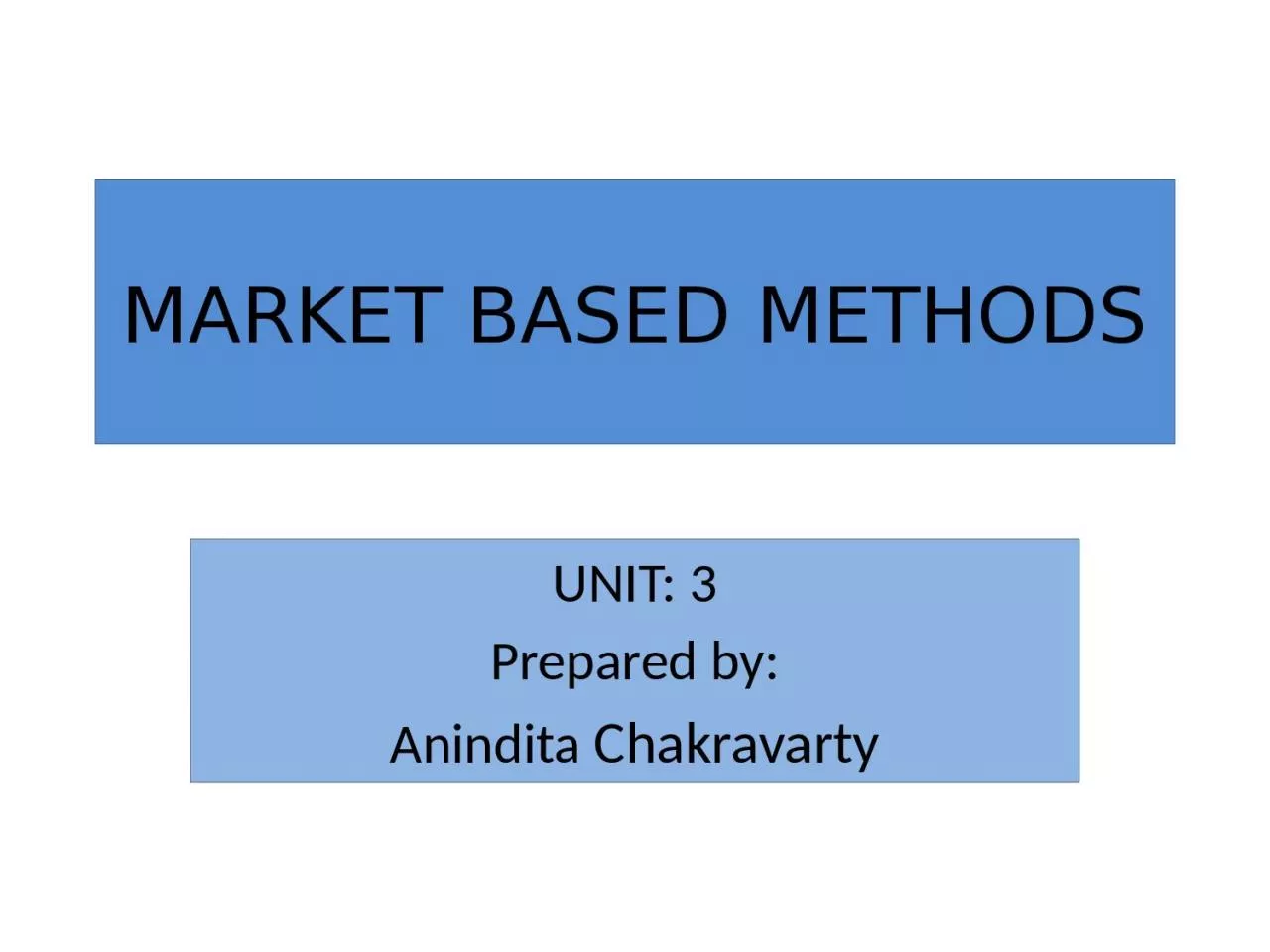

Prepared by Anindita Chakravarty Dear students under this topic we will discuss the following types of Market Based Methods to solve Environmental Problems Emission Fee or Tax Environmental Standard ID: 1027605
Download Presentation The PPT/PDF document "MARKET BASED METHODS UNIT: 3" is the property of its rightful owner. Permission is granted to download and print the materials on this web site for personal, non-commercial use only, and to display it on your personal computer provided you do not modify the materials and that you retain all copyright notices contained in the materials. By downloading content from our website, you accept the terms of this agreement.
1. MARKET BASED METHODSUNIT: 3Prepared by:Anindita Chakravarty
2. Dear students, under this topic we will discuss the following types of Market Based Methods to solve Environmental Problems: Emission Fee or TaxEnvironmental StandardTradable Pollution PermitLiability LawCarbon trading
3. Emission Fee or TaxA pollution fee is a payment based on the quantity of pollutants discharged into the environment. A regulated party pays a fixed amount for each unit of pollution emitted or disposed.Fees can apply to air and wastewater emissions and solid wastes.Fees are effective tools for managing the environment because they associate cost with polluting activities.Even at low levels, fees provide incentive and may be helpful in raising awareness of the costs of pollution. However, designing pollution fees and taxes that minimize the total cost of pollution (environmental damage cost plus control costs) is difficult because: There is a lack of data on pollution damage; The ability to precisely measure emissions is difficult.
4. Environmental StandardEnvironmental standards are administrative regulations or civil law rules implemented for the treatment and maintenance of the environment.The basis for the standards is determined by scientific opinions from varying disciplines, the views of the general population, and social contextEnvironmental Standards means regulations governing designs with regard to noise characteristics, fuel venting, and exhaust emissions of civil aeronautical products and appliances. Environmental quality standards can be introduced nationwide or for particular geographical areas, such as counties or municipalities.Example:Ambient air (SFS 2010:477) and Regulations on air quality assessment (NFS 2016:9), Fish and bivalve waters (SFS 2001:554) Noise (SFS 2004:675), Bathing Water Regulation (SFS 2008:218).
5. Tradable Pollution PermitTradable pollution permits are trade schemes that give companies a legal right to pollute a certain amount per fixed time span.Firms that pollute less can then sell their leftover pollution permits to firms that pollute more. The point of this is that polluting firms and public agencies differ in their ability to abate their pollution – some can do it easily and cheaply, for others it would be more difficult and costly. Consequently, tradable pollution permits can be a cost effective way to achieve a reduction in overall pollution.Trading in pollution permits arises in the following situations: Permits to discharge into specific water bodies issued to local firms and wastewater treatment plants (e.g. Fox River, USA); Salinity Credits (e.g. for coal mining and power companies discharging into the Hunter River in Australia);
6. Liability LawLiability laws are a very attractive policy instrument in a market economy as if an individual agent inflicts a damage on another party, liability rules allow the damage costs to be attributed to the agent who caused the damage.The originator of a damage will be forced to pay, and he will not be able to transplant some of the social costs of his action on someone elseThe message of liability law is straightforward: an economic activity should internalize its liability costs. It should not be engaged in if it cannot support its liability costs. If a product cannot carry its liability costs, it should not be on the market. An investment project should include its liability costs; if it fails to do so, it should not be undertaken. A waste deposit or an energy plant should bear its liability costs.
7. Carbon TradingCarbon trading is an exchange of credits between nations designed to reduce emissions of carbon dioxide.The carbon trade originated with the 1997 Kyoto Protocol, with the objective of reducing carbon emissions and mitigating climate change and future global warming.Carbon emissions trading allows countries that have higher carbon emissions to purchase the right to release more carbon dioxide into the atmosphere from countries that have lower carbon emissions.However,It can be difficult to measure how much carbon is produced, and therefore difficult to know what level of carbon tax to charge.It is difficult to know the true cost of carbon emissions on the environment and future generations.Carbon taxes can cause the possibility of tax evasion. For example, firms try to mask the true level of pollution
8. THANK YOU